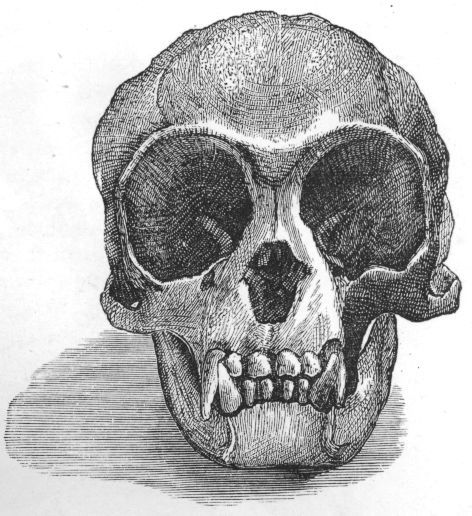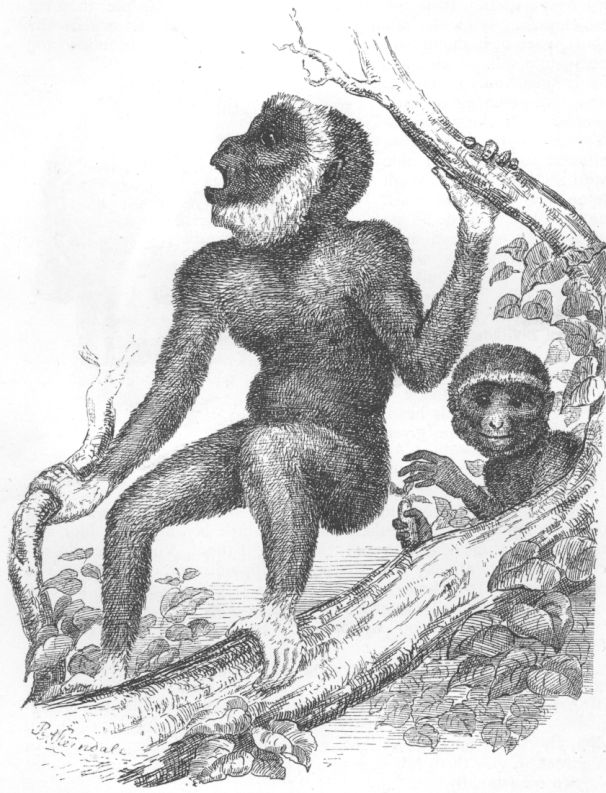| Page 3 | |
|
Natural History of the Mammalia of India and Ceylon - by Robert A. Sterndale F.R.G.S., F.Z.S. (1884) | |
| prev page next page | contents |
"GENUS HYLOBATES - THE GIBBONS",
Which, with the long arms of the Ourangs and the receding forehead of the Chimpanzee, possess the callosities of the true monkeys, but differ from them in having neither tail nor cheek pouches. They are true bipeds on the ground, applying the sole of the foot flatly, not, as Cuvier and others have remarked of the Ourangs, with the outer edge of the sole only, but flat down, as Blyth, who first mentions it, noticed it, with the thumb or big toe widely separated.
1. HYLOBATES HOOLUCK. "The White-fronted Gibbon".
NATIVE NAMES. - "Hooluck", "Hookoo".
HABITAT. - Garo and Khasia Hills, Valley of Assam, and Arracan.
DESCRIPTION. - Males deep black, marked with white across the forehead. Females vary from brownish black to whitish-brown, without, however, the fulvous tint observable in pale specimens of the next species.
"In general they are paler on the crown, back, and outside of limbs, darker in front, and much darker on the cheeks and chin." - "Blyth".
SIZE. - About two feet.

Skull of "Hylobates hooluck"
I think of all the monkey family this Gibbon makes one of the most interesting pets. It is mild and most docile, and capable of great attachment. Even the adult male has
been caught, and within the short space of a month so completely tamed that he would follow and come to a call. One I had for a time, some years ago, was a most engaging
little creature. Nothing contented him so much as being allowed to sit by my side with his arm linked through mine, and he would resist any attempt I made to go away. He
was extremely clean in his habits, which cannot be said of all the monkey tribe. Soon after he came to me I gave him a piece of blanket to sleep on in his box, but the
next morning I found he had rolled it up and made a sort of pillow for his head, so a second piece was given him. He was destined for the Queen's Gardens at Delhi, but
unfortunately on his way up he got a chill, and contracted a disease akin to consumption. During his illness he was most carefully tended by my brother, who had a little
bed made for him, and the doctor came daily to see the little patient, who gratefully accepted his attentions; but, to their disappointment, he died. The only objection
to these monkeys as pets is the power they have of howling, or rather whooping, a piercing and somewhat hysterical "Whoop-poo! whoop-poo! whoop-poo!" for several minutes,
till fairly exhausted.
They are very fond of swinging by their long arms, and walk something like a tipsy sailor. A friend, resident on the frontiers of Assam, tells me that the full-grown adult pines and dies in confinement. I think it probable that it may miss a certain amount of insect diet, and would recommend those who cannot let their pets run loose in a garden to give them raw eggs and a little minced meat, and a spider or two occasionally.
In its wild state this Gibbon feeds on leaves, insects, eggs and small birds. Dr. Anderson notices the following as favourite leaves: "Moringa pterygosperma" (horse-radish tree), "Spondias mangifera" (amra), "Ficus religiosa" (the pipal), also "Beta vulgaris"; and it is specially partial to the "Ipomoea reptans" (the water convolvulus) and the bright-coloured flowers of the Indian shot ("Canna Indica"). Of insects it prefers spiders and the Orthoptera; eggs and small birds are also eagerly devoured.
2. HYLOBATES LAR. "The White-handed Gibbon".
HABITAT. - Arracan, Lower Pegu, Tenasserim, and the Malayan Peninsula.

"HYLOBATES LAR". "HYLOBATES HOOLUCK"
DESCRIPTION. - "This species is generally recognisable by its pale yellowish, almost white hands and feet, by the grey, almost white, supercilium, whiskers and beard, and
by the deep black of the rest of the pelage." - "Anderson".
SIZE. - About same as "H. hooluck".
It is, however, found in every variety of colour, from black to brownish, and variegated with light-coloured patches, and occasionally of a fulvous white. For a long time I supposed it to be synonymous with "H. agilis" of Cuvier, or "H. variegatus" of Temminck, but both Mr. Blyth and Dr. Anderson separate it. Blyth mentions a significant fact in distinguishing the two Indian Gibbons, whatever be their variations of colour, viz.: ""H. hooluck" has constantly a broad white frontal band either continuous or divided in the middle, while "H. lar" has invariably white hands and feet, less brightly so in some, and a white ring encircling the visage, which is seldom incomplete."[3]
[Footnote 3: There is an excellent coloured drawing by Wolf of these two Gibbons in the 'Proceedings of the Zoological Society,' 1870, page 86, from which I have partly adapted the accompanying sketch.]
"H. lar" has sometimes the index and middle fingers connected by a web, as in the case of "H. syndactylus" (a Sumatran species very distinct in other respects). The very closely allied "H. agilis" has also this peculiarity in occasional specimens. This Gibbon was called ""agilis"" by Cuvier from its extreme rapidity in springing from branch to branch. Duvaucel says: "The velocity of its movements is wonderful; it escapes like a bird on the wing. Ascending rapidly to the top of a tree, it then seizes a flexible branch, swings itself two or three times to gain the necessary impetus, and then launches itself forward, repeatedly clearing in succession, without effort and without fatigue, spaces of forty feet."
Sir Stamford Raffles writes that it is believed in Sumatra that it is so jealous that if in captivity preference be given to one over another, the neglected one will die of grief; and he found that one he had sickened under similar circumstances and did not recover till his rival (a Siamang, "H. syndactylus") was removed.
3. "HYLOBATES SYNDACTYLUS". "The Siamang".
HABITAT. - Tenasserim Province, Sumatra, Malayan Peninsula.
DESCRIPTION. - A more robust and thick-set animal than the two last; deep, woolly, black fur; no white supercilium nor white round the face. The skull is distinguished from the skull of the other Gibbons, according to Dr. Anderson, by the greater forward projection of the supraorbital ridges, and by its much deeper face, and the occipital region more abruptly truncated than in the other species. The index and middle toes of the foot are united to the last phalange.
SIZE. - About three feet.
This Gibbon is included in the Indian group on the authority of Helfer, who stated it to be found in the southern parts of the Tenasserim province. Blyth mentions another distinguishing characteristic - it is not only larger than the other Gibbons, but it possesses an inflatable laryngeal sac. Its arms are immense - five feet across in an adult of three feet high.
The other species of this genus inhabiting adjacent and other countries are "H. Pileatus" and "H. leucogenys" in Siam; "H. leuciscus", Java; "H. Mulleri" and "H. concolor", Borneo.
